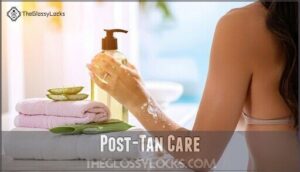This site is supported by our readers. We may earn a commission, at no cost to you, if you purchase through links.
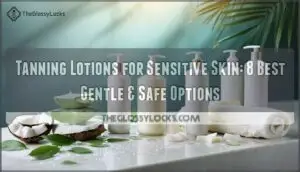
Tanning lotions for sensitive skin are specifically formulated without the usual suspects that trigger reactions – think fragrance-free, hypoallergenic formulas packed with soothing ingredients like aloe vera and coconut oil.
These gentle alternatives won’t leave you looking like a lobster or dealing with breakouts.
Look for products labeled "non-comedogenic" and "dermatologist-tested" to play it safe.
Your sensitive skin deserves better than a one-size-fits-all approach, and the right formula can transform your tanning game completely.
Table Of Contents
- Key Takeaways
- Choosing Tanning Lotion
- Sensitive Skin Considerations
- Top 8 Tanning Lotions
- 1. Vitamin Sea Natural Bronzer Lotion
- 2. Hempz Hypoallergenic Dark Tan Maximizer
- 3. Sea Said Tanning Lotion Accelerator
- 4. Ed Hardy Coconut Kisses Tanning Lotion
- 5. ProTan Dark Hypoallergenic Tanning Accelerator
- 6. Black Coconut Dark Tanning Lotion
- 7. Devoted Creations Facial Tanning Lotion
- 8. Sun Bum Vegan Tanning Lotion
- Application and Care Tips
- Tanning Lotion Benefits
- Frequently Asked Questions (FAQs)
- What is the best suntan lotion for sensitive skin?
- What is the best way to tan with sensitive skin?
- Can I tan if I have sensitive skin?
- What is a safe alternative to tanning?
- Can people with sensitive skin tan?
- What’s the best fake tan for eczema?
- Why does self tanner give me a rash?
- How to choose a tanning lotion for sensitive skin?
- What is good for severe skin sensitivity?
- What is the best indoor tanning lotion?
- Conclusion
Key Takeaways
- Choose fragrance-free, hypoallergenic formulas – You’ll want to look for products specifically labeled as dermatologist-tested and non-comedogenic, with soothing ingredients like aloe vera and coconut oil that won’t trigger reactions or breakouts.
- Always patch test before full application – You should test any new tanning lotion on a small skin area 24 hours before use to ensure it won’t cause irritation, and avoid tanning during skin flare-ups.
- Prep your skin properly for even results – You’ll need to gently exfoliate 24 hours before tanning and moisturize dry areas like knees and elbows 30 minutes prior to prevent patchy, uneven color.
- Build your tan gradually with natural ingredients – You’re better off using products with natural DHA and starting slowly over several days rather than rushing the process, which helps prevent irritation while achieving natural-looking results.
Choosing Tanning Lotion
When you’re choosing a tanning lotion for sensitive skin, you’ll want to focus on hypoallergenic formulas that won’t trigger irritation or allergic reactions.
Look for fragrance-free options with skin-soothing ingredients like aloe vera and chamomile, as these gentle components help protect your delicate skin while you achieve your desired glow.
Hypoallergenic Formulas
When your skin acts like a drama queen, hypoallergenic formulas become your backstage pass to safe tanning.
When sensitive skin throws tantrums, gentle tanning lotions become your peacekeeping diplomats for drama-free bronzing.
These specially crafted tanning lotions undergo clinical testing to guarantee reduced irritation and allergy prevention.
Brands like Hempz and Australian Gold prioritize ingredient safety in their formula composition, creating nonirritating tanners that deliver a beautiful sensitive skin tan without the theatrical breakouts.
You can find various lotion options online.
Fragrance-Free Options
Synthetic fragrances can trigger reactions in people with scent sensitivity.
Fragrance-free tanners offer reduced irritation and safer ingredient profiles for your delicate skin.
These natural alternatives prioritize minimal ingredients without compromising results.
You can find a fragrance free option that suits your needs.
Consider these fragrance-free options:
- Unscented formulas – Zero added fragrances
- Natural ingredient bases – Plant-derived components only
- Hypoallergenic certification – Dermatologist-tested safety
- Sensitive skin labeling – Specifically formulated protection
Skin-Soothing Ingredients
Look for ingredients that act like a gentle hug for your sensitive skin.
Aloe vera provides instant aloe benefits, while oatmeal relief calms irritation and reduces redness.
Chamomile calm soothes inflammation, and coconut hydration keeps skin soft.
These skin-soothing ingredients, along with botanical extracts, create a protective barrier that helps sensitive skin tan comfortably without the usual drama, providing a sense of coconut hydration.
Sensitive Skin Considerations
You’re looking for tanning lotions that cater to your sensitive skin, and this is vital to examine the ingredients and properties that will work best for you.
When choosing a tanning lotion, you should opt for natural and organic ingredients, non-comedogenic properties, and avoid harsh chemicals to minimize irritation and guarantee a safe tanning experience.
Natural and Organic Ingredients
When shopping for a natural tanning lotion, consider:
- Botanical Extracts
- Organic DHA
- Ingredient Sourcing
- Sustainable Tanning
- Eco-Friendly Formulas
You want a product with natural ingredients, like organic tanning lotion, for sensitive skin, ensuring a safe and gentle tanning experience with eco-friendly formulas.
Non-Comedogenic Properties
When choosing tanning lotions, consider noncomedogenic properties to prevent pore clogging and acne prevention, ideal for sensitive skin and various skin types.
Ensuring oil control with hypoallergenic and fragrance-free options through careful ingredient research.
Avoiding Harsh Chemicals
You prioritize hypoallergenic and fragrance-free options to minimize irritant reduction on sensitive skin.
Opt for paraben-free and dye-free tanning lotions with natural DHA, reducing chemical sensitivities and promoting a safer glow, considering natural ingredients for better results.
Look for products with USDA Organic certification to guarantee ingredient purity.
Top 8 Tanning Lotions
You’re looking for the best tanning lotions for sensitive skin, and we’re here to help.
Here are the top 8 gentle and safe options, including Vitamin Sea Natural Bronzer Lotion and Hempz Hypoallergenic Dark Tan Maximizer, that you can consider for a healthy glow.
1. Vitamin Sea Natural Bronzer Lotion
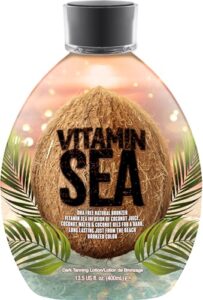
You’re considering Vitamin Sea Natural Bronzer Lotion, a great option for sensitive skin.
It’s infused with coconut juice, water, and oils for deep hydration. This lotion provides a clean, streak-free finish and is suitable for all skin types.
It’s also tattoo-friendly and made in the USA, making it a reliable choice for those seeking a gentle tanning experience.
Best For: individuals with sensitive skin looking for a gentle and reliable tanning experience.
- Some users note difficulty squeezing lotion from the bottle with slippery hands
- Mixed opinions on bronzing effectiveness, with some seeing visible results after multiple uses
- No significant or immediate results for some users, requiring multiple applications
- Provides a clean, streak-free, and stain-free finish
- Infused with coconut juice, water, and oils for deep hydration and a tropical scent
- Suitable for all skin types and tattoo-friendly
2. Hempz Hypoallergenic Dark Tan Maximizer
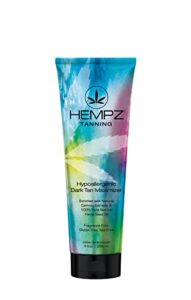
You’re looking for a gentle tanning lotion, and Hempz Hypoallergenic Dark Tan Maximizer is a great option.
It’s infused with 100% Pure Natural Hemp Seed Oil for deep hydration and nourishment.
This fragrance-free formula also contains soothing natural calming extracts like oatmeal, making it suitable for sensitive skin.
It promotes long-lasting moisture and exceptional softness.
Best For: individuals with sensitive skin who want a gentle and hydrating tanning lotion that promotes long-lasting moisture and exceptional softness.
- Infused with 100% Pure Natural Hemp Seed Oil for deep hydration and nourishment
- Fragrance-free formula makes it suitable for sensitive skin
- Promotes long-lasting moisture and exceptional softness
- May not be suitable for those who prefer a strong fragrance in their tanning lotion
- Requires regular reapplication to maintain desired tan intensity
- Can be expensive compared to other tanning lotions on the market
3. Sea Said Tanning Lotion Accelerator
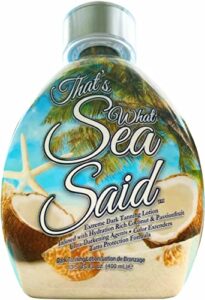
You’re checking out the Sea Said Tanning Lotion Accelerator, a great option for sensitive skin.
It stimulates melanin production with a proprietary tyrosine blend, helping you achieve a faster, darker tan.
This lotion is safe for outdoor and indoor use, and its gentle formula won’t irritate your skin.
Give it a try for a natural-looking glow.
Best For: individuals with sensitive skin who want to achieve a natural-looking glow without irritating their skin.
- Stimulates melanin production for a faster and darker tan
- Safe for outdoor and indoor use, including tanning beds
- Gentle and non-irritating formula with natural ingredients like coconut and passionfruit
- Higher price point at $52 CAD, which may be a consideration for some buyers
- Requires consistent sun exposure for noticeable tanning results
- Some users reported random red splotches, although this is not a confirmed common issue
4. Ed Hardy Coconut Kisses Tanning Lotion
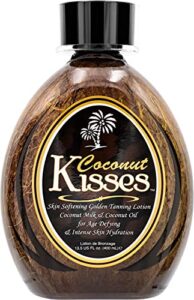
You’re considering Ed Hardy Coconut Kisses Tanning Lotion, which contains coconut milk, oil, and cocoa butter for hydration.
It delivers a dark golden tan without bronzing agents, making it suitable for indoor and outdoor use.
This lotion is cruelty-free, gluten-free, and mineral oil-free, providing a gentle and safe option for sensitive skin.
Best For: beginners or those seeking a natural, gradual tan, especially for fair skin types, who want a cruelty-free and gentle tanning lotion.
- Some users find it provides a light tan, recommending additional bronzers for darker results.
- Mixed reviews on moisturizing level, with some users finding it less hydrating than expected.
- Issues with lid durability and packaging, such as cracked bottles, have been reported in some cases.
- Delivers a dark golden tan without bronzing agents, making it suitable for indoor and outdoor use.
- Provides deep hydration and skin softening due to ingredients like coconut milk, coconut oil, and cocoa butter.
- Non-greasy, absorbs easily, and does not stain hands, body, or clothes, making it a convenient option.
5. ProTan Dark Hypoallergenic Tanning Accelerator
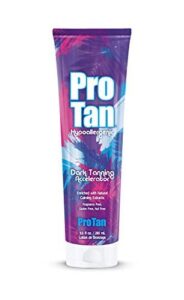
You’re looking for a reliable tanning accelerator.
ProTan Dark Hypoallergenic Tanning Accelerator is a great option, offering a hypoallergenic formula that’s gentle on sensitive skin.
It promotes a dark, long-lasting tan without irritating your skin, making it an excellent choice for those who want a safe and effective tanning experience.
For fair skin, it’s best to use tanning lotions with added SPF protection.
Best For: individuals with sensitive skin who want a reliable and safe tanning accelerator that promotes a long-lasting tan without irritation.
- Offers a hypoallergenic formula that’s gentle on sensitive skin
- Promotes a dark, long-lasting tan without irritating the skin
- Free from gluten, nuts, parabens, and other common irritants
- No longer available on Amazon
- May cause adverse reactions in some users, such as a severe itchy rash
- Mixed reports on fragrance presence, though generally described as minimal or absent
6. Black Coconut Dark Tanning Lotion
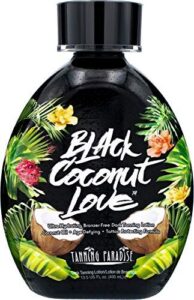
You’ll love the Black Coconut Dark Tanning Lotion, which provides deep skin hydration with coconut milk, coconut butter, and cocoa butter.
It protects tattoos and prevents color fading, while also acting as a dark tanning accelerator with age-defying skincare benefits.
This lotion is perfect for sensitive skin, offering a gentle and safe tanning experience.
Best For: individuals with sensitive skin looking for a gentle and safe tanning experience with deep skin hydration and age-defying skincare benefits.
- Provides deep skin hydration with coconut milk, coconut butter, and cocoa butter
- Protects tattoos and prevents color fading
- Acts as a dark tanning accelerator with age-defying skincare benefits
- May not be suitable for those who prefer instant bronzing results
- Limited information available about the product’s ingredients and potential allergies
- No information available about the product’s price or value compared to similar products
7. Devoted Creations Facial Tanning Lotion
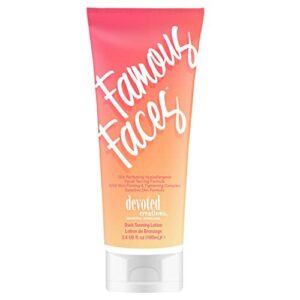
You’re considering Devoted Creations Facial Tanning Lotion, a hypoallergenic formula with anti-aging benefits.
It contains Matrixyl for skin tightening and Strivitan to boost collagen production.
This lotion is suitable for sensitive skin, providing a bronzed glow while firming and tightening the skin, making it an excellent option for those seeking a gentle and safe tanning experience.
Best For: sensitive skin types and individuals seeking a hypoallergenic facial tanning lotion with anti-aging benefits.
- Thicker consistency may feel greasy, especially for oily skin types
- No significant darkening effect on legs compared to regular tanning lotion
- Some users experience packaging quality control issues
- Provides a bronzed glow while firming and tightening the skin
- Suitable for daily use and lasts a long time
- Moisturizes sensitive skin without irritation or itching
8. Sun Bum Vegan Tanning Lotion
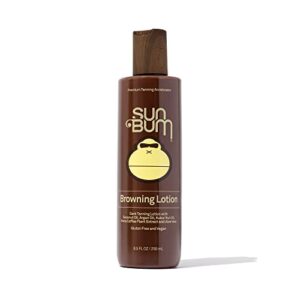
Sun Bum Vegan Tanning Lotion brings a gentle approach to sensitive skin tanning with its thoughtful formulation.
You’ll appreciate the coconut oil and aloe vera combination that moisturizes while soothing irritation-prone skin.
The Kona coffee extract adds natural bronzing without harsh chemicals, making it reef-friendly too.
Since it’s free from octinoxate and oxybenzone, you’re protecting both your skin and the environment.
Apply liberally fifteen minutes before sun exposure, and you’ll get that sun-kissed glow without compromising your skin’s comfort or health.
Best For: People with sensitive skin who want a gentle, reef-friendly tanning option that moisturizes while providing natural bronzing effects.
- Contains skin-soothing ingredients like aloe vera and coconut oil that calm and moisturize sensitive skin
- Reef-friendly formula free from octinoxate and oxybenzone protects marine environments
- Kona coffee extract provides natural bronzing without harsh chemicals or artificial additives
- Requires 15-minute wait time before sun exposure which may be inconvenient for some users
- May need frequent reapplication every two hours to maintain effectiveness
- Vegan formulation might not provide as intense tanning results as traditional lotions with stronger ingredients
Application and Care Tips
Proper application techniques help you achieve an even, natural-looking tan while protecting your sensitive skin from irritation.
You’ll need to prepare your skin beforehand and follow specific care steps to maintain your glow without causing reactions.
Moisturizing Dry Areas
Pre-Tan Hydration matters more than you think. Your knees, elbows, and ankles soak up moisture like sponges, making Even Application tricky without proper prep. Smart moisturizing prevents your sensitive skin tan from looking patchy.
Many effective moisturizers contain hyaluronic and ceramides to hydrate skin. This is crucial for achieving a streak-free result.
To ensure the best results, follow these steps:
- Apply fragrance-free moisturizer 30 minutes before tanning
- Focus on naturally dry areas like knees and elbows
- Choose aloe vera tanner-compatible moisturizers for Barrier Repair
- Use eczema-friendly tanner products to boost Ingredient Absorption
- Prioritize skin hydration for optimal results
By prioritizing skin hydration and following these guidelines, you can achieve a more natural-looking tan.
Gentle Exfoliation
Exfoliation methods for sensitive skin require extra care before tanning.
Use sensitive scrubs with oatmeal or sugar rather than harsh abrasives.
Pre-tan prep should happen 24 hours before application to avoid skin irritation.
Gentle formulas prevent skin redness and allow even product absorption.
A quality scrub matters for the best results.
Limit exfoliation frequency to twice weekly maximum, focusing on knees, elbows, and ankles where skin exfoliation matters most, using gentle formulas and a quality scrub.
Post-Tan Care
After your gentle prep work, maintaining your glow requires thoughtful post-tan care.
Hydration importance can’t be overstated—moisturize daily with soothing ingredients like aloe vera for skin calming and sunburn relief.
Choose loose clothing choices to prevent irritation and skin redness.
Tan extenders help preserve your bronze while skin moisturizing keeps everything smooth and comfortable.
Tanning Lotion Benefits
You’ll discover that quality tanning lotions for sensitive skin offer more than just color enhancement.
These specialized formulas nourish your skin with hydrating ingredients like aloe vera and shea butter while providing anti-aging benefits that keep your skin healthy and smooth.
Skin Nourishment
Quality tanning lotions deliver essential skin nourishment through vitamin infusion and hydrating ingredients.
You’ll find shea butter softness and coconut oil benefits work together, creating a protective barrier for sensitive skin.
These soothing ingredients prevent dryness while maintaining skin hydration.
Extract advantages from aloe vera and natural ingredients guarantee your skin stays healthy throughout the tanning process, with the benefits of coconut oil.
Natural Ingredients Emphasis
Natural ingredients work like a gentle hug for your sensitive skin.
Natural ingredients embrace your delicate skin with the tenderness it deserves, delivering comfort without compromise.
When you choose tanning lotions packed with nature’s best, you’re giving your skin what it craves without the harsh stuff.
Here’s why natural ingredients make all the difference:
- Botanical Extracts calm irritated skin instantly
- Organic Oils create a protective barrier
- Natural DHA bronzes without burning
- Mineral Bronzers enhance your glow safely
- Vegan Formulas respect your skin’s needs
For effective sun defense, consider lotions with non-nano zinc oxide.
Skin Hydration Benefits
Moisturizing tanning lotion acts like a drink of water for thirsty skin.
These products pack Hydration Ingredients such as shea butter and hyaluronic acid that boost Moisture Retention while you tan.
You’ll notice improved Dryness Prevention and stronger Skin Barrier protection.
The skin hydration benefits from quality moisturizing formulas help sensitive skin stay comfortable during tanning sessions.
Anti-Aging Properties
Beyond hydration, you’ll discover that premium tanning lotions pack serious antiaging punch.
Many formulas boost collagen production while delivering antioxidant protection against environmental damage.
- Wrinkle Reduction: Matrixyl peptides smooth fine lines during tanning sessions
- Cellular Repair: Vitamin A accelerates skin renewal and fights aging signs
- Collagen Boost: Advanced formulas stimulate natural collagen for firmer skin
- Skin Firming: Antiaging ingredients tighten while you bronze
Frequently Asked Questions (FAQs)
What is the best suntan lotion for sensitive skin?
Like choosing armor for battle, you’ll want hypoallergenic, fragrance-free formulas with natural DHA.
Look for soothing ingredients like aloe vera and coconut oil.
Always patch test first—your skin’s comfort matters most.
What is the best way to tan with sensitive skin?
Start with gradual tanning lotions containing natural DHA and hypoallergenic ingredients.
Always patch test first, moisturize beforehand, and choose fragrance-free formulas.
Build your tan slowly over several days to avoid irritation and ensure a smooth, natural looking tan.
Can I tan if I have sensitive skin?
Yes, you can tan with sensitive skin, but you’ll need extra care.
Choose hypoallergenic, fragrance-free products with natural ingredients like aloe vera.
Always patch test first and avoid tanning during skin flare-ups.
What is a safe alternative to tanning?
Think of self-tanning as your skin’s best friend – it delivers that golden glow without UV damage.
You’ll get beautiful color using lotions with natural DHA, avoiding sun exposure that could irritate sensitive skin.
Can people with sensitive skin tan?
People with sensitive skin can tan, but you’ll need extra caution.
Choose hypoallergenic, fragrance-free products with natural ingredients like aloe vera.
Always patch test first and avoid tanning during skin flare-ups for safer results.
What’s the best fake tan for eczema?
Choose fragrance-free, hypoallergenic self-tanners with natural DHA and soothing ingredients like aloe vera or shea butter. Always patch test first and avoid application during eczema flare-ups to prevent irritation.
Why does self tanner give me a rash?
Self-tanner rashes happen because you’re likely allergic to DHA, fragrances, or harsh chemicals in the formula.
Your skin’s throwing a tantrum!
Switch to fragrance-free, hypoallergenic options with natural ingredients like aloe vera.
How to choose a tanning lotion for sensitive skin?
Look for fragrance-free, hypoallergenic formulas with natural ingredients like aloe vera and coconut oil.
Always patch test first, avoid harsh chemicals like synthetic DHA, and choose gradual tanners for gentler results.
What is good for severe skin sensitivity?
What’s the secret to protecting ultra-reactive skin?
You’ll need fragrance-free, hypoallergenic formulas with natural DHA and soothing ingredients like aloe vera.
Always patch test first and choose gentle, gradual tanners over harsh chemical options, using hypoallergenic formulas to ensure safety.
What is the best indoor tanning lotion?
Hempz Hypoallergenic Dark Tan Maximizer stands out for indoor tanning with sensitive skin.
You’ll get deep hydration from hemp seed oil while avoiding harsh chemicals that irritate.
It’s dermatologist-tested and builds color gradually, providing a dark tan.
Conclusion
Surprisingly, having sensitive skin doesn’t mean you’re doomed to pale forever.
The right tanning lotions for sensitive skin can deliver that coveted glow without triggering irritation or breakouts.
By choosing fragrance-free, hypoallergenic formulas with gentle ingredients like aloe vera, you’ll protect your skin while achieving natural-looking results.
Remember to patch test new products and follow proper application techniques.
Your sensitive skin deserves products that work with it, not against it, for safe and beautiful tanning results.




